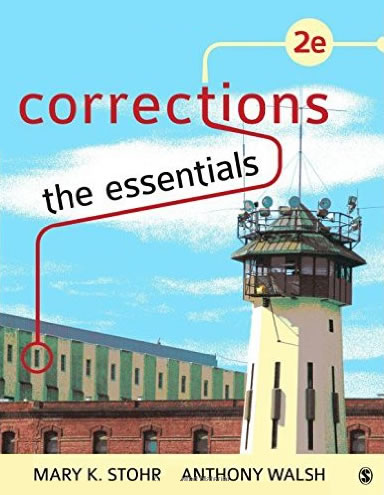Instant download Instructor Manual for Corrections: The Essentials 2nd Second Edition, Mary K. Stohr, Anthony Walsh pdf docx epub after payment.

Product details:
- ISBN-10 : 1483372243
- ISBN-13 : 978-1483372242
- Author: Mary K. Stohr; Anthony Walsh
Corrections: The Essentials, is a comprehensive, yet compact version of corrections by two esteemed authors who are experts in the field. The text addresses the most important topics in corrections in a shorter and more cost-effective format. The Second Edition continues to cover the history, development, and future of corrections as well as provides new coverage of Ethics and the Death Penalty. The book and rsquo;s brevity makes it an excellent core textbook that can easily be supplemented with additional reading materials.
Table of contents:
Chapter 1: The Philosophical and Ideological Underpinnings of Corrections
Introduction: What Is Corrections?
From Arrest to Punishment
The Theoretical Underpinnings of Corrections
Short History of Correctional Punishment
The Emergence of Positivism: Should Punishment Fit the Offender or the Offense?
The Function of Punishment
The Philosophical Assumptions behind Justifications for Punishment
The Major Punishment Justifications
Retribution
Deterrence
Incapacitation
Selective Incapacitation
Rehabilitation
Reintegration
The Four Legal Traditions and Why They are Useful to Know
The Due Process and Crime Control Models and Cultural Comparisons
The Crime Control Model
The Due Process Model
Is the United States Hard or Soft on Crime?
Chapter 2: Correctional History: Ancient Times–Colonial Jails
Introduction: The Evolving Practice of Corrections
Themes: Truths That Underlie Correctional Practice
Early Punishments in Westernized Countries
Enlightenment – Paradigm Shift
Colonial Jails and Prisons
Chapter 3: Correctional History: The 17th–20th Century
Introduction: The Grand Reforms
Early Modern Prisons and the Pennsylvania and New York Models
Early Prisons and Jails Not Reformed
The Renewed Promise of Reform
Southern and Northern Prisons and the Contract and Lease Systems, and Industrial Prisons
Correctional Institutions or Warehouse Prisons?
Themes That Prevail in Correctional History
Chapter 4: Ethics and Corrections
Introduction: To Do the Right Thing!
Defining Ethics: What is Right (and Wrong)?
Ethical Foundation For Professional Practice
Why People Behave Unethically
How to Prevent Unethical Behavior and to Promote Ethical Work Practices
War on Drugs = Attack on Ethics?
Chapter 5: Sentencing: The Application of Punishment
What is Sentencing?
Types of Sentences: Indeterminate, Determinate, and Mandatory
Habitual Offender Statutes
Other Types of Sentences: Shock, Split, and Non-Custodial Sentences
Victim Impact Statements
Sentencing by Civil Commitment for Sex Offenders
Problem-Solving Courts
Drug Courts
Sentencing Disparity, Legitimate and Illegitimate
Structuring Sentencing: The Presentence Investigation Report
Structuring Sentencing: The Presentence Investigation Report
Structured Sentencing: Sentencing Guidelines
The Future of Sentencing Guidelines
The American Correctional Association’s Statement on Sentencing
Chapter 6: Jails
Introduction: The Community Institution
Jail Types
Jail Inmates and Their Processing
Overcrowding
Gender, Juveniles, Race, and Ethnicity
The Poor and the Mentally Ill
Medical Problems
Substance Abuse and Jails
Suicides, Gangs and Sexual Violence in Jails
Innovations in Jails: New Generation/Podular Direct Supervision Jails, Community Jails,
Chapter 7: Community Corrections: Probation and Intermediary Sanctions
The Origins of Probation
Number and Demographic Characteristics of Offenders on Probation
Why do we Need Community Corrections?
The Probation Officer Role
Models of Probation Supervision
Probation Violations and Graduated Sanctions
Probation Officer Stress
Community Supervision and Recidivism
Engaging the Community to Prevent Recidivism
Intermediate Sanctions
Work Release
Intensive Supervision Probation
Shock Probation/Parole and Boot Camps
Victim-Offender Reconciliation Programs (VORPs)
Chapter 8: Prisons
Introduction: The State of Prisons
Prison Organizations
Prison Value?
Attributes of the Prison That Shape the Experience
The Prison Subculture
Gangs and the Prison Subculture
Violence
Solutions: Strategies to Reduce Violence, Mature Coping and Social Support
Special Populations
Chapter 9: The Corrections Experience for Staff
Introduction
The State of the Work in Correctional Institutions and Programs
Why the Need to Require More Education and Training Exists
Stanford Prison Experiment
Organizational-Level Factors That Affect the Correctional Workplace
Individual-Level Factors That Affect the Correctional Workplace
Correctional Roles
The Subculture and Socialization
Staff Interactions With Inmates
Other Issues for Staff: Stress, Burnout, Turnover
Ethics
Perceived Benefits of Correctional Work
Chapter 10: Community Corrections: Parole and Prisoner Reentry
What is Parole?
Parole Boards
What Goes in Must Come Out: Prisoner Reentry into the Community
The Impact of Imprisonment and Reentry on Communities
What Makes for a Successful Reentry?
Determining Parole “Success”
Parole Violations and Graduated Sanctions
Halfway Houses
House Arrest, Electronic Monitoring, and Global Positioning Systems
Concluding Remarks on Reenty and Recidivism
Chapter 11: Women and Corrections
Introduction
History and Growth
Current Figures on the Number of Women and Girls in Corrections
Females in Corrections: Needs, Programming, Abuse, and Adjustment
Female Correctional Officers
Chapter 12: Minorities and Corrections
Introduction
Defining Race, Ethnicity, Disparity, and Discrimination
A Legacy of Racism: African Americans, American Indians, Hispanics, Asian Americans
The Connection Between Class and Race/Ethnicity
Minorities: Policies and Practices That Have Resulted in Increased Incarceration
Minorities: Adjustment to Incarceration
Minorities Working in Corrections
Chapter 13: Juveniles and Corrections
Introduction: Delinquency and Status Offending
The Extent of Delinquency
The Juvenile Brain and Juvenile Behavior
History and Philosophy of Juvenile Justice
Childhood in the United States
The Beginning of the Juvenile Courts
Processing Juvenile Offenders
Juveniles Waived to Criminal Court
Extending Due Process to Juveniles
Juveniles and the Death Penalty
Juvenile Community Corrections
Intensive Probation
Residential and Institutional Juvenile Corrections
Chapter 14: Legal Issues in Corrections
Introduction
The Rule of Law
The Hands-Off Period: 1866–1963
The Prisoners’ Rights Period: 1964–1978
First Amendment
Fourth Amendment
Eighth Amendment
Fourteenth Amendment
The Civil Commitment of Sex Offenders
Prisoners’ Rights in Comparison Countries
Curtailing Prisoner Petitions
Legal Issues in Probation and Parole
Chapter 15: Correctional Programming and Treatment
The Rise and Fall (and Rise Again) of Rehabilitation
The Shift from “Nothing Works” to “What Works?”
Evidence-Based Practices
Cognitive-Behavioral Therapy
Substance Abuse Programming
Drug Treatment with Swift Consequences for Failure: Hawaii’s HOPE Program
Therapeutic Communities
Pharmacological Treatment
Anger Management
Sex Offenders and Their Treatment
Mentally Ill Offenders
Chapter 16: The Death Penalty
The Death Penalty and Public Opinion
Methods of Execution used in the United States
Legal Challenges to the Death Penalty
Does the Death Penalty Deter?
Financial Costs and the Death Penalty
Racial Disparity in Death Sentences
The Issue of Victim’s Race
Women and the Death Penalty
The Chivalry Hypotheses
The Evil Women Hypotheses
The Death Penalty and Mental Disability
The Death Penalty and Mental Illness
The Innocence Revolution
Some Concerns with DNA Technology
Some Concerns with Neuroimaging Technology
Chapter 17: Corrections in the 21st Century
Introduction: Learning From the Past So That We Have Hope for the Future
Punitive Policies Yield Overuse of Corrections
Decarceration
Professionalization
Corrections Is a Relationship Business
Privatization
Concluding Thoughts
People also search:
Corrections: The Essentials 2nd Second Edition
Corrections: The Essentials 2nd Second Edition pdf
Corrections: The Essentials
corrections the essentials 4th edition
corrections the essentials 3rd edition pdf





